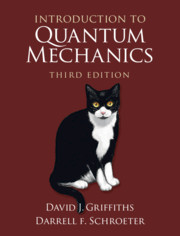|
Introduction to Quantum Mechanics, 3/e |
|
|
Griffiths
|
|
 |
|
|

|
|
This bestselling undergraduate quantum mechanics textbook is now available in a re-issued, affordable edition from Cambridge University Press. The text first teaches students how to do quantum mechanics, and then provides them with a more insightful discussion of what it means. The author avoids the temptation to include every possible relevant topic, instead presenting students with material that they can easily focus on in a complete treatment with few distractions and diversions. Fundamental principles are covered, quantum theory is presented, and special techniques are developed for attacking realistic problems. The innovative two-part coverage is entertaining and informative, organizing topics under basic theory and assembling an arsenal of approximation schemes with illustrative applications linked closely to the text.
Changes and additions to the new edition of this classic textbook include a new chapter on symmetries, new problems and examples, improved explanations, more numerical problems to be worked on a computer, new applications to solid state physics, and consolidated treatment of time-dependent potentials.
- Provides clear and accessible explanations of the foundations of quantum mechanics, using an attractive and informal style
- It is thorough, with an appropriate amount of mathematical rigor and a good variety of examples and problems
- Students emerge with a confident understanding of what the theory says and how to apply it, a solid foundation for more advanced work, and an appreciation for one of the greatest products of the human mind
|
|
|
|

|
|
Part I. Theory:
1. The wave function
2. Time-independent Schrodinger equation
3. Formalism
4. Quantum mechanics in three dimensions
5. Identical particles
6. Symmetry
Part II. Application:
7. Time-independent perturbation theory
8. The variational principle
9. The WKB approximation
10. Scattering
11. Quantum dynamics
12. Afterword
Appendix A. Linear algebra
Index.
|
|
|
|

|
|
David J. Griffiths, Reed College, Oregon
David J. Griffiths received his B.A. (1964) and Ph.D. (1970) from Harvard University. He taught at Hampshire College, Mount Holyoke College, and Trinity College before joining the faculty at Reed College in 1978. In 2001?02 he was visiting Professor of Physics at the Five Colleges (University of Massachusetts, Amherst, Mount Holyoke, Smith, and Hampshire), and in the spring of 2007 he taught Electrodynamics at Stanford. He retired in 2009. Griffiths is a Consulting Editor of The American Journal of Physics, and a Fellow of the American Physical Society. In 1997 he was awarded the Millikan Medal by the American Association of Physics Teachers. He has spent sabbaticals at SLAC, Lawrence Berkeley Laboratory, and University of California, Berkeley. Although his Ph.D. was in elementary particle theory, his recent research is in electrodynamics and quantum mechanics. He is the author of over fifty articles and four books: Introduction to Electrodynamics (4th edition, Cambridge, 2013), Introduction to Elementary Particles (2nd edition, 2008), Introduction to Quantum Mechanics (2nd edition, Cambridge, 2016), and Revolutions in Twentieth-Century Physics (Cambridge, 2012).
Darrell F. Schroeter, Reed College, Oregon
Darrell F. Schroeter is a condensed matter theorist. He received his B.A. (1995) from Reed College and his Ph.D. (2002) from Stanford University where he was a National Science Foundation Graduate Research Fellow. Before joining the Reed College, Oregon, faculty in 2007, Schroeter taught at both Swarthmore College and Occidental College. His record of successful theoretical research with undergraduate students was recognized in 2011 when he was named as a KITP-Anacapa scholar.
|
|
|
|
 교수님 안녕하십니까.
교수님 안녕하십니까.